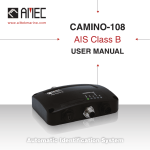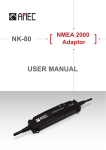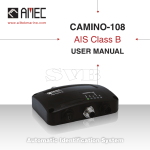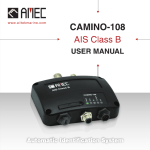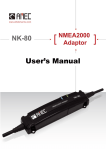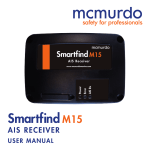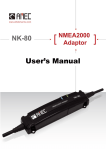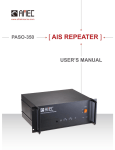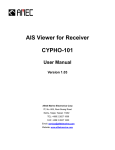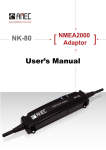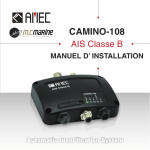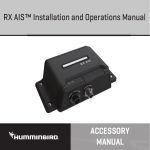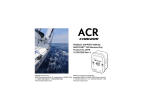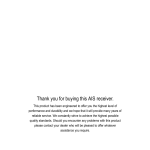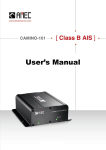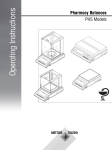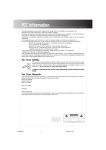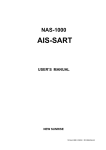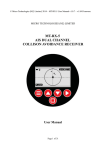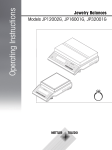Download CYPHO 150 - Alltek Marine
Transcript
CYPHO 150 AIS Receiver USER MANUAL General Information Manual Edition 1.12 i. Copyright The entire contents of this instruction manual, including any future updates, revisions, and modifications, shall remain the property of AMEC at all times. Unauthorized copies or reproduction of this manual, either in part or whole, in any form of print and electronic media, is prohibited. The contents herein can only be used for the intended purpose of this manual. ii. Disclaimer AMEC is devoted to publish and maintain this product manual. As we continue to improve our AIS products to satisfy all customers’ needs, information in this document is subject to change without notice. AMEC does not make any representations or warranties (implied or otherwise) regarding the accuracy and completeness of this document and shall in no event be liable for any loss of profit or any commercial damage, including but not limited to special, incidental, consequential, or other damage. iii. Product Category This product is categorized as “protected” in accordance with the requirements as defined in IEC 60945. iv. Disposal Instruction Do not dispose of this device with unsorted waste. Improper disposal may be harmful to the environment and human health. Please refer to your local waste authority for information on return and collection systems in your area. I WARNING! WARNING: The AIS receiver must be installed and configured in conformity with the provided instructions in the manual in order to maximize the device performance. WARNING: Please bear in mind that not all vessels are equipped with AIS transponders and therefore may not be visible to this receiver. Likewise, in the event of overcrowded port traffic, vessels equipped with AIS transponder may not be visible to this receiver. WARNING: DO NOT DISASSEMBLE OR MODIFY THE EQUIPMENT. Improper disassembly or modification could cause personal injury and will invalidate the guarantee. WARNING: While most of the installation can be performed by the owner or the crew, a final commissioning can be done by your local agent/dealer when needed or required. AMEC and the local agent/dealer will not bear any responsibilities over any damages resulted from improper installation by unauthorized agent/dealer. II FOREWORD AMEC thanks you for the purchase of your new CYPHO 150 Automatic Identification System (hereinafter called “AIS”). Wherever you sail now, you can have a better control of your surrounding sea, and have an enjoyable voyage. CYPHO 150 is strictly tested at the factory to meet the rigorous demands of the marine environment. With proper use, installation, and maintenance, the equipment will serve loyally and reliably at its optimum. For sales, services, and technical supports, please contact your local AMEC representatives or Alltek Marine Electronics Corp at [email protected] or [email protected]. You are always welcome to visit our website at www.alltekmarine.com for new product status and company update. Thank you again. Be safe III Table of Content 1 2 3 SYSTEM OVERVIEW ........................................................................................... 1 1.1 Product Description ..................................................................................... 1 1.2 Comparison of CYPHO 150 Series ................................................................ 1 1.3 Equipment in the Box ................................................................................... 3 1.4 External Connections ................................................................................... 4 1.5 What is AIS? ................................................................................................. 5 1.6 AIS Message Type ........................................................................................ 6 INSTALLATION ................................................................................................... 8 2.1 CYPHO 150 Connection Interface ................................................................. 9 2.2 CYPHO 150S Connection Interface ............................................................. 10 2.3 Mounting Instructions ............................................................................... 11 2.4 VHF Antenna Installation ........................................................................... 13 2.5 Connecting to NMEA 0183 devices ............................................................ 15 2.6 Connecting to Power Supply ...................................................................... 19 CONFIGURATION ............................................................................................. 20 3.1 USB Driver Installation ............................................................................... 20 3.2 CYPHO Configuration Software .................................................................. 22 3.2.1 Connecting the Receiver to your PC .............................................. 22 i 3.2.2 Baud Rate Setting: ......................................................................... 25 3.2.3 Diagnosis ....................................................................................... 26 3.3 4 5 AMEC AIS Viewer Software Installation ..................................................... 28 GETTING STARTED ........................................................................................... 29 4.1 CYPHO 150 LED Indicators ......................................................................... 29 4.2 CYPHO 150S LED Indicators ........................................................................ 30 SPECIFICICACIONS ........................................................................................... 31 5.1 Product Specifications................................................................................ 31 5.2 Dimensions ................................................................................................ 33 6 TROUBLESHOOTING ........................................................................................ 35 7 ABBREVIATIONS .............................................................................................. 36 8 FCC INTERFERENCE STATEMENT ....................................................................... 37 DECLARATION OF CONFORMITY.............................................................................. 38 AMEC WORLDWIDE WARRANTY ............................................................................. 38 ii iii 1 SYSTEM OVERVIEW 1.1 Product Description The AMEC CYPHO 150/150S is an AIS receiver series. It receives AIS navigation data from AIS-equipped vessels nearby and improves navigation safety. CYPHO 150 series is designed to inter-operate with AIS Class A or Class B transponders, and any other AIS station operating on the AIS VHF data link. CYPHO 150 series is built with two parallel AIS receivers in one box with optimized sensitivity. Having CYPHO 150 series AIS receiver on board, you can monitor the status of the vessels equipped with AIS transponders in the surrounding area by receiving their dynamic information (position, speed, SOG, etc.), static information (ship name, MMSI, call sign, etc.), and voyage related information (cargo type, destination, etc.). Equipped with USB2.0 and NMEA 0183, CYPHO 150 series enables connectivity to most available peripherals in the market. CYPHO 150S with integrated VHF splitter allows the usage of a single VHF antenna to combine AIS and VHF operation. 1.2 Comparison of CYPHO 150 Series Description Number of AIS Channels USB port NMEA 0183 CYPHO 150 CYPHO 150S 2 2 1 1 1 input, 1 output 1 input, 1 output (baud rate independent) (baud rate independent) - Yes Built-in VHF Splitter 1 CYPHO 150 CYPHO 150S Front Front Back Back 2 1.3 Equipment in the Box Please contact your supplier immediately if there is any item missing. 3 1.4 External Connections 4 1.5 What is AIS? The Automatic Identification System (AIS) is a Very High Frequency (VHF) radio broadcasting system that transfers packets of data over the VHF data link (VDL) and enables AIS equipped vessels and shore-based stations to exchange identification information and navigational data. Ships with AIS transponders continually transmit their ID, position, course, speed and other data to all nearby ships and shore stations. Such information can aid greatly in situational awareness and provide a means to assist in collision avoidance. AIS equipment is standardized by ITU, IEC, IALA and IMO and is subject to approval by a certification body. The following AIS devices have been developed for variant applications. AIS Class A: mandated by the IMO for vessels of 300 gross tonnages and upwards engaged on international voyages, cargo ships of 500 gross tonnages and upwards, as well as passenger ships. It transmits typically on 12.5 watt output power. AIS Class B: provides limited functionality and is intended for non-SOLAS commercial vessels and recreational vessels. It transmits typically on 2 watt output power. AIS Receiver: only receives AIS signal and it does not have transmitter to send out AIS signal. Suitable for recreational vessel that does not want to send out its vessel information. 5 AIS Base Station: is provided by aids-to-navigation authorities to enable the ship to shore / shore to ship transmission of information. Networked AIS Base Stations can assist in providing overall maritime domain awareness. AIS AtoN (Aids to Navigation): provides an opportunity to transmit position and status of buoys and lights through the same VDL, which can then show up on AIS-ready devices within the range. AIS SART: Search and Rescue Transmitter using AIS can be used to assist in determining the location of a vessel in distress. It is typically used on life rafts. AIS on Search and Rescue (SAR) Aircraft: used on airplanes and helicopters to assist search and rescue operation. 1.6 AIS Message Type The CYPHO 150 models can receive AIS messages from both Class A and Class B AIS transponders as well as from AIS Base Station, AIS AtoN, and AIS SART/MOB. The message types are listed as below table. The messages in gray color are transmitted only from class A AIS device. 6 Type of Message Static Data Voyage Related Data Dynamic Data Dynamic Reports SRM Data Details Maritime Mobile Service Identity (hereinafter called “MMSI”) number IMO number Call sign and name Type of ship Length and beam GPS Antenna location Draught of the ship Cargo information Destination Estimate Time of Arrival (hereinafter called “ETA”) Position of the vessel Coordinated Universal Time (hereinafter called “Time in UTC”.) Course Over Ground (hereinafter called “COG”) Speed Over Ground (hereinafter called “SOG”) Heading Rate of turn Navigational status Speed of the ship Status of the ship Alarm Safety 7 2 INSTALLATION Please note the following guidelines for selecting a suitable installation location for CYPHO 150. The surrounding temperature should be maintained between -15°C~55°C. The receiver must be installed at least 0.5m away from a compass. The device is not designed to be fully waterproof. Therefore, is not recommended to install the device in a location that will be subjected to spray or water submersion. The device should not be installed in flammable or hazardous locations such as near a fuel tank. The device should be installed in a location where the indicator is easily visible in which the LED lights provides important information about the status of the receiver. 8 2.1 CYPHO 150 Connection Interface VHF Antenna Power, USB, NMEA 0183 Figure 1 CYPHO 150 Connection Interface 9 2.2 CYPHO 150S Connection Interface VHF Radio VHF Antenna Power, USB, NMEA 0183 Figure 2 CYPHO 150S Connection Interface 10 2.3 Mounting Instructions Platform Mounting Wall Mounting (flat surface) Figure 3 Mounting Instructions (1) 11 Figure 4 Mounting Instructions (2) 12 2.4 VHF Antenna Installation The quality and positioning of the antenna is the most important factor dictating AIS performance. It is recommended that a VHF antenna with omni-directional vertical polarization and specifically tuned for AIS operation band is used. Since the range of VHF signals is largely decided by line of sight distance, AIS antenna should be placed as high as possible and at least 5 meters away from any constructions made of conductive materials. To avoid interference, the VHF antenna location should be placed in accordance to Figure 5. DISTANCE BETWEEN ANTENNAS The safe distance from a transmitting VHF antenna is 60cm. DO NOT BEND CABLES Bending cables may cause damages to the inner wires and impair overall the performances. USES OF CABLE TUBE Each coaxial cable should be set up separately and can only be set up in a single cable tube. INSULATION ON CONNECTING PORT Connecting port of the coaxial cable should be insulated. 13 5˚ High power transmitting antenna VHF Antenna 10m Other transmitting antenna Other VHF Antenna The recommended horizontal distance between antennas is 10m. The recommended vertical distance between antennas is 2m. Figure 5 VHF Antenna Installation 14 2.5 Connecting to NMEA 0183 devices CYPHO 150 is typically connected to an external chartplotter via NMEA 0183 output wiring connection. (please refer to Figure 8) For the advanced multiplexing application, CYPHO 150 series gets input from one NMEA0138 device and pass it to another NMEA 0183 device together with AIS information. The input and output NMEA 0183 ports support independent baud rates. CYPHO 150 series supports three baud rates: 4800, 9600, and 38400. The default baud rate is 38400. Use the provided configuration utility to change the baud rates. See the illustration Figure 6. Figure 6 NMEA 0183 Connection 15 The figure below describes how to wire your AIS receiver with NMEA 0183 devices and power source. Figure 7 Wiring Instructions 16 External NMEA 0183 Device (RS422) (Chartplotter) CYPHO 150 NMEA 0183 RXP RXN TXP TXN TXP TXN RXP RXN Figure 8 NMEA 0183 Connection illustration Core Color at CYPHO 150 NMEA 0183 Signal Signal Direction (CYPHO 150) External NMEA 0183 Device Brown Receive + (RXP) Input n/a Blue Receive – (RXN) Input n/a Yellow Transmit + (TXP) Output Data Input + (RXP) Green Transmit – (TXN) Output Data Input – (RXN) 17 External NMEA 0183 (GPS Source) CYPHO 150 NMEA 0183 RXP RXN TXP TXN TXP TXN External NMEA 0183 (Chartplotter) RXP RXN Figure 9 Core Color at CYPHO 150 Brown NMEA 0183 Multiplexing Connection NMEA 0183 Signal Signal Direction (CYPHO 150) External NMEA 0183 Devices Receive + (RXP) Input Data Output + (TXP) Blue Receive – (RXN) Input Data Output - (TXN) Yellow Transmit + (TXP) Output Data Input + (RXP) Green Transmit – (TXN) Output Data Input – (RXN) 18 2.6 Connecting to Power Supply All CYPHO 150 models are designed having no physical On/Off switch. Thus, the vessel’s operation determines the unit’s power status. The AIS Receiver requires a 12V or 24V DC power supply (9.6 – 31.2V). The red wire and the black wire on the 12 pin cable are used to connect the power supply’s positive and negative terminals. Practically, it is suggested to use the 2 amp fuse panel before connecting directly to the battery/power supply. CYPHO 150 can also be powered via a standard PC USB port (5 volts at 500 mA) or an USB power adapter (5 volts at 500 mA). Note: If PC could not recognize USB connection after a power restart on CYPHO 150, please re-plug the USB connector. 19 3 CONFIGURATION 3.1 USB Driver Installation Your PC needs to install the USB driver in able to connect the AIS receiver. Locate the USB driver in the CD-ROM. Follow the instructions below to finish the installation. Step 1: Open the USB Driver file and double click on USBDriverInstaller.exe to install the driver. Please click on Install Drivers to continue. Figure 10 USB Driver Installation (1) 20 Step 2: A security reminder appears and asks for your confirmation. Click Install to proceed. Figure 11 USB Driver Installation (2) Step 3: Driver installation is completed. Close the window directly using the close window icon. Figure 12 USB Driver Installation (3) 21 3.2 CYPHO Configuration Software Install the AMEC Cypho Configuration Software from the CD-ROM by following the on-screen instructions. 3.2.1 Connecting the Receiver to your PC There are 2 options to connect the software with your AIS receiver: Auto: The system will scan all connected ports and their available baud rates and establish connection automatically. Manual: Configure baud rate and serial port manually. The default baud rate is 115200. 22 Serial port number Default Baud Rate NMEA 0183 Baud Rate Figure 13 Software Installation (1) To find the serial port number, click Start → Control Panel → Device Manager. Expand the Ports section and look for USB Communications Port. In the sample picture below, the serial port number is 30. 23 Serial port number Figure 14 Software Installation (2) Enter the value and hit “Connect” to link the computer to the receiver. 24 3.2.2 Baud Rate Setting: Each CYPHO 150 model has one NMEA 0138 port and the baud rate of its input and output ports can be set independently. To adjust the values, set the desired baud rates for the NMEA input and output and then click on “Config Device” to apply new the setting. Figure 15 Baud Rates 25 3.2.3 Diagnosis The Diagnosis tab has two submenus, System Check and Data Log. System Check System Check retrieves following information and statuses from the receiver: Firmware Version, Product Serial Number, RX position reports. Figure 16 System Check 26 Data Log The Data Log enables user to record received AIS information. To enable or disable the recording of AIS information, use the “Enable Log” check box. Click “Save” to save the record at a preferred location on the PC via USB. To ensure the log is recorded the device must stay connected to the PC via USB and the AMEC CYPHO Configuration Software is running. To clear the current listing, use the “Clear” button. Figure 17 Data Log 27 3.3 AMEC AIS Viewer Software Installation AIS Viewer is a complementary application that provides a simple access for user to view AIS information on PC. The application provides basic features to browse the relative positions of surrounding vessels and the dynamic and static information regulated by IMO. For professional uses, we recommend connecting AMEC CYPHO 150 Series with other marine electronic products such as ECS or Radar for better performances. The AMEC AIS Viewer program and its operation manual are included in the CD-ROM. Figure 18 AMEC AIS Viewer 28 4 GETTING STARTED 4.1 CYPHO 150 LED Indicators Power Error AIS Rx Figure 19 CYPHO 150 LED Indicators LED INDICATIONS Indicator Power Indication Normal Steady Green Description Device in normal operation Error Flashing Red A system error is detected AIS Rx Flashing Green Receiving of AIS message in either AIS Channel 1 or Channel 2 29 4.2 CYPHO 150S LED Indicators Power Error AIS Rx Radio Tx Figure 20 CYPHO 150S LED Indicators LED INDICATIONS Indicator Power Error Indication Normal Steady Green Flashing Red AIS Rx Flashing Green Radio Tx Flashing Green 30 Description Device in normal operation A system error is detected Receiving of AIS message in either AIS Channel 1 or Channel 2 VHF radio is transmitting 5 SPECIFICICACIONS 5.1 Product Specifications APPLICABLE STANDARDS IEC 62287-1 (applicable parts) ITU-R M.1371 (applicable parts) IEC 60945 (applicable parts) IEC 61162 (applicable parts) AIS RECEIVER Number of AIS Receivers 2 channels CH-1 Default CH 87B (161.975MHz) CH-2 Default CH 88B (162.025MHz) Channel Bandwidth 25KHz Message Format AIS Class A & B messages Data Rate 9,600bps / per channel AIS Receiver Sensitivity -112dBm Max. Usable Sensitivity PER ≤ 20% @ -107 dBm POWER SUPPLY Supply Voltage 12 / 24V DC USB Power 5V DC / 500 mA Power Consumption <1.50 Watt LED INDICATION CYPHO 150 Power, Error, AIS Rx CYPHO 150S Power, Error, AIS Rx, Radio Tx 31 INTERFACE VHF Antenna Connector Female Type M (PL 259) NMEA 0183 38400 (default), 9600, 4800 bps USB 2.0 Supported VHF Radio Connector (CYPHO 150S only) Female Type M (PL 259) ENVIRONMENTAL Operating Temperature -15°C~55°C Storage Temperature -25°C~70°C Humidity Operation 0~95% RH at 40°C Vibration IEC 60945 Waterproof IPX2 PHYSICAL Size in mm (w) 128 mm (4.99 inch) Size in mm (h) 36 mm (1.40 inch) Size in mm (d) 88 mm (3.43 inch) Weight 210g (incl. cable) Cable Length (power, USB, NMEA 0183) 1M RF PERFORMANCE (CYPHO 150S only) Frequency Range 156.025 ~ 162.025 MHz AIS Receiver Sensitivity -110dBm (when not connecting to DSC) Receiver Path: 3.5dB VHF Port Insertion Loss Transmit Path: 1.2dB Certification CE, FCC 32 5.2 Dimensions Applicable to all CYPHO 150 models. Front View Figure 21 Front View 33 Side View 36 mm 1m 88 mm Figure 22 Side View 34 6 TROUBLESHOOTING Does CYPHO 150 work with my chartplotter? New chartplotters typically support AIS function. Be sure your chartplotter has ① the latest firmware update. Ensure the baud rate for the inbound NMEA port on the chartplotter is matched. ② How do I know the CYPHO 150 functions normally? The Power LED indicates in steady Green. The AIS Rx LED indicates in flashing Green. ③ Can CYPHO 150 pass the received AIS information to PC? Yes, the unit can pass the AIS message sentences through USB port to PC. Why the unit does not power up? Check the unit has adequate power. Be sure that the polarities of the power wires are correct (red is positive, black ④ is negative ground) ⑤ Can CYPHO 150 NMEA interface be connected to more than two external NMEA devices? Yes, through a NMEA multiplexing connection. ⑥ Can a VHF antenna other than AMEC VHF antenna be used for CYPHO 150? Yes, as long as it is a marine type VHF antenna. 35 7 ABBREVIATIONS AIS COG CPA CSTDMA DSC ECS ETA GPS IMO MMSI SOG SRM TCPA TDMA UTC VHF VTS Automatic Identification System Course Over Ground Distance to Closest Point of Approach Carrier-sense time division multiple access Digital Selective Calling Electronic Chart System Estimated Time of Arrival Global Positioning System International Maritime Organization Maritime Mobile Service Identity Speed Over Ground Safety Related Message Time to Closest Point of Approach Time Division Multiple Access Coordinated Universal Time Very High Frequency Vessel Traffic Service 36 8 FCC INTERFERENCE STATEMENT This equipment has been tested and found to comply with the limits for a Class A digital device, pursuant to Part 15 of FCC Rules. These limits are designed to provide reasonable protection against harmful interference in a residential installation. This equipment generates uses and can radiate radio frequency energy and, if not installed and used in accordance with the instructions, may cause harmful interference to radio communications. However, there is no guarantee that interference will not occur in a particular installation. If this equipment does cause harmful interference to radio or television reception, which can be determined by turning the equipment off and on, the user is encouraged to try to correct the interference by one of the following measures: Reorient or relocate the receiving antenna. Increase the separation between the equipment and receiver. Connect the equipment into an outlet on a circuit different from that to which the receiver is connected. Consult the dealer or an experienced radio/TV technician for help. This device complies with Part 15 of the FCC Rules. Operation is subject to the following two conditions: 1) This device may not cause harmful interference, and 2) this device must accept any interference received, including interference that may cause undesired operation. 37 DECLARATION OF CONFORMITY Hereby, Alltek Marine Electronics Corp. (AMEC) declares that this CYPHO 150/150S is in compliance with the essential requirements and other relevant provisions of Directive 1999/5/EC. AMEC WORLDWIDE WARRANTY Limited warranty Subject to the terms, conditions and limitations set forth in this Worldwide Limited Warranty (hereinafter the “Warranty”), AMEC warrants that its products, when properly installed and used, will be free from defects in material and workmanship for a period of twelve (12) months, from the date of first purchase (the ‘Warranty Period’) For the purposes of this warranty, ‘date of first purchase’ means the date that the product was purchased by the first retail customer, or by the institutional customer, or in the case of a product installed on a new vessel or any other marine related platform by a certified AMEC original equipment manufacturer (a ‘AMEC OEM’), the date that such vessel was purchased by the first retail customer. AMEC will, at its sole option, repair or replace any defective products or components returned during the Warranty Period in accordance with the terms, conditions and limitations set forth below. Such repairs or replacement will be the sole remedy of the customer under this Warranty. 38 Standard Warranty Service To qualify for standard warranty service the product must be returned to a AMEC-certified service agent (i) within the Warranty Period, and (ii) within thirty (30) days of the alleged product failure. Any products returned must be securely packaged and sent pre-paid and insured to AMEC or to a AMEC-certified service agent. All products returned must be accompanied by a copy of the original sales receipt to be eligible for standard warranty service. Other conditions This Warranty is fully transferable provided that you furnish the original proof of purchase to the AMEC -certified service agent. This Warranty is void if the seal label is removed or defaced. THE LIABILITY OF AMEC TO A CUSTOMER UNDER THIS WARRANTY, WHETHER FOR BREACH OF CONTRACT, TORT, BREACH OF STATUTORY DUTY OR OTHERWISE SHALL IN NO EVENT EXCEED AN AMOUNT EQUAL TO THE TOTAL PURCHAE PRICE OF THE PRODUCT GIVING RISE TO SUCH LIABILITY AND IN NO EVENT SHALL AMEC BE LIABLE FOR SPECIAL, INCIDENTAL, CONSEQUENTIAL OR INDIRECT DAMAGES OR LOST OF GOODWILL, REPUTATION, LOSS OF OPPORTUNITY OR INFORMATION, DATA, SOFTWARE OR APPLICATIONS. In the event that any term or provision contained in this Warranty is found to be invalid, illegal or unenforceable by a court of competent jurisdiction, then such provision shall be deemed modified to the extent necessary to make such provision enforceable by such court, taking into account the intent of the parties. All AMEC products sold or provided hereunder are merely aids to navigation. It is the responsibility of the user to exercise discretion and proper navigational skill independent of any AMEC product. 39 Alltek Marine Electronics Corporation 5F, No. 37, Ji-Hu Road, Neihu District, Taipei, 11492, Taiwan Tel: +886 2 2627 1599 Fax: +886 2 2627 1600 Email: [email protected] Website: www.alltekmarine.com















































